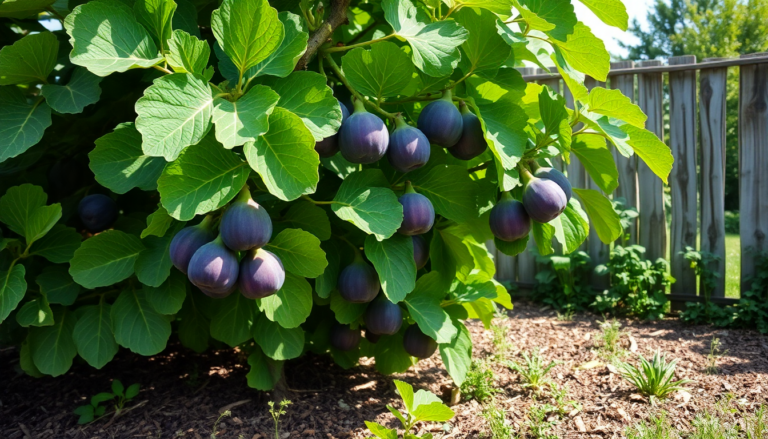Argomenti trattati
Fig trees are a delightful addition to any garden, especially for those who appreciate both their aesthetic appeal and the delicious fruits they produce. With their large, lobed leaves providing ample shade and their sweet figs ready for harvest, fig trees are not just beautiful but also incredibly rewarding to grow. Understanding the basics of fig tree care can transform your backyard into a fruitful oasis, ripe with possibilities for both snacking and baking.
Why grow fig trees?
Growing fig trees has numerous benefits beyond their delectable fruits. These trees are relatively low-maintenance and adaptable to various climates, making them an ideal choice for many gardeners. Award-winning landscape designer Christian Douglas highlights that fig trees are easy to prune, require minimal water, and thrive in full sun. With a history stretching back over 10,000 years, fig trees have stood the test of time, proving their worth in gardens across the globe.
One of the key advantages of fig trees is their ability to produce fruits that ripen directly on the tree, ensuring maximum flavor. Unlike some fruits that need to be harvested early and ripen off the vine, figs must be soft to the touch when picked, promising a sweet and juicy treat. With proper care, fig trees can yield a bountiful harvest, often producing two crops in a single growing season in warmer climates.
Planting your fig tree
The ideal time to plant fig trees is during their dormant phase. This timing can vary based on your climate—fall is best for warmer regions, while spring is the go-to for areas with colder winters. Figs thrive in sunny locations, so choosing a spot that receives plenty of sunlight is crucial. Douglas advises that a southwestern wall could be beneficial in cooler climates, creating a microclimate that helps the tree absorb warmth.
Space is also an important consideration. Fig trees need room to grow, typically requiring 15 to 25 feet between each tree. This spacing not only promotes healthy growth but also helps prevent issues with roots encroaching on your home’s foundation. Depending on the variety, fig trees can reach heights of six to thirty feet, so plan accordingly.
Watering and fertilizing your fig tree
Watering is a critical aspect of fig tree care, especially during the summer months. Douglas recommends a deep watering once a week, which can help concentrate the sugars in the fruit, leading to a sweeter harvest. However, if you prefer a larger shade tree with bushier foliage, increasing watering to twice a week may be beneficial. Fertilizing your fig tree in the spring is equally important, and a balanced, slow-release fertilizer can provide the necessary nutrients for robust growth throughout the season.
As the fig tree grows, monitoring its health and adjusting care as needed is essential. Figs are susceptible to various pests and diseases, so being aware of the signs of trouble can help you maintain a thriving tree. Regular inspections can catch issues early, ensuring your fig tree remains healthy and productive.
Pruning your fig tree
Pruning is another important practice that can enhance the health and yield of your fig tree. The best time for formative pruning is in the spring, approximately two weeks after the last frost. This practice encourages strong growth and can help manage the tree’s size. If branches begin to obstruct pathways or crowd other plants, they can be trimmed as necessary. Just be sure to wear long sleeves and gloves, as fig sap can irritate the skin.
By maintaining an appropriate pruning schedule, you can encourage your fig tree to produce fruit more efficiently and keep your garden looking tidy. Pruning also allows for better air circulation and sunlight penetration, both of which are vital for fruit development.
Popular fig tree varieties
There are numerous fig tree varieties suited to different climates, making it easier for gardeners to find the perfect match for their local conditions. For instance, the Black Mission fig is a favorite for its jammy sweetness and resistance to pests. It thrives in USDA Hardiness Zones 7 to 9 and is known for its reliable production. On the other hand, the Brown Turkey fig is ideal for slightly cooler climates, flourishing in zones 6 to 9 with its delightful melon and honey flavors.
For colder regions, the Chicago Hardy fig tree stands out, capable of surviving soil temperatures as low as -20 degrees Fahrenheit. Its fruits offer sweet hints of cherry and strawberry, making it a fantastic choice for northern gardeners. Lastly, the Desert King fig, although not suited for high heat, can withstand temperatures down to 5 degrees Fahrenheit, producing extra sweet fruits.
Growing figs in containers
If you live in a colder climate or have limited space, consider growing fig trees in pots. This method allows for flexibility in placement and makes it easier to protect the trees during harsh winters. Douglas suggests using old wine barrels for an attractive and practical planting solution. These containers can be wheeled into a shed or greenhouse as needed, ensuring your fig trees stay safe from frost.
Once your fig tree is well-established, propagation can be a fun project. Taking cuttings from your mature tree is a great way to expand your garden or share with friends. With the right care, you can cultivate new trees from your existing stock.

